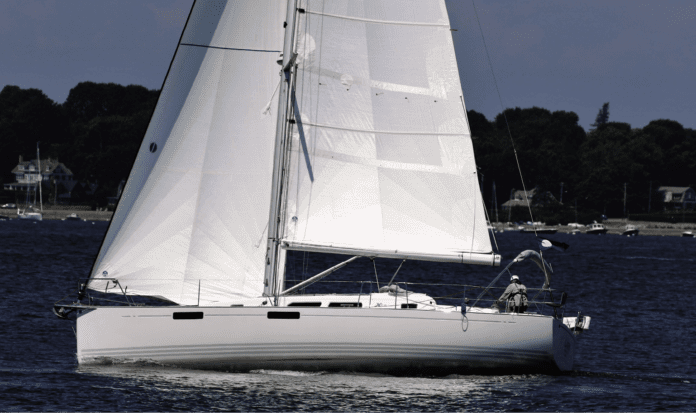PRAISE FOR X-YACHTS
Your report “Stowing Gear on Deck,” in the July 2022 issue had some good tips for line and miscellaneous storage on board. X-Yachts, the maker of my XC38, LARK, has several great solutions that I wanted to share.
First, all control lines lead into the cockpit coach roof. Once they come through the clutches and winches they are stored in a bin under the floor just aft of the companionway. Second, there is a nice storage bin built into the table that holds all sorts of gear (see photos).

The XC38 is a fast, very comfortable cruising boat that does not get enough attention. The boat was purchased new from X-Yachts in May 2017. It is an excellent boat for short handed sailing. I’ve since sailed it in the 2018 single-handed Offshore 160, the 2019 Bermuda 1-2, and I do at least one double handed race each year.
One of the more interesting design aspects is that the entire boat can be picked by a crane with a single strap that attaches to the galvanized steel frame under the floorboards.
Stan White
Lark, X-yachts XC 38
Noank, CT
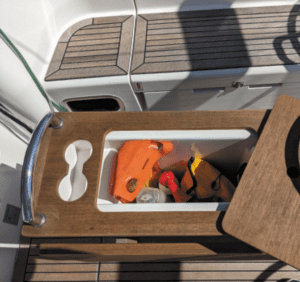
PRAISE FOR SOVEREL 33
We have owned a 1974/75 30 foot Soverel since 2005. Currently, we have it in the Riverside Marine boatyard in Ft. Pierce, Fl. and are doing extensive work on it. She is starting to look terrific— decks and hull repainted, and now we’re working on rewiring and the interior. We replaced the original diesel engine with a Yanmar in 2006.
We live in Sebastian, FL and have had a lot of great adventures between the Bahamas and the Indian River. Somewhere along the way, we lost our centerboard and would love to replace it or make a new one based on the original specifications. Do you happen to know where we could find the original specifications for the centerboard; dimensions, weight and material used when the boat was manufactured?
Alternatively, are there any good sites online that you know of where we might be able to find a used Soverel centerboard for our make & model?
Lisa Wright
Soverel 33, Adios
Ft. Pierce, FL
This is the second Soverel that has contacted us regarding a centerboard issue, so there may be a business opportunity for someone. We’re still following leads on your centerboard question. Maybe one of our readers may offer some suggestions. To read about a centerboard issue on the Soverel 36, see “Stopping Centerboard Pin Corrosion” https://www.practical-sailor.com/boat-maintenance/stopping-centerboard-pin-corrosion.
VINEGAR FOR HEAD?
Re your recent eblast, “Marine Toilet Maintenance Tips” Next time you test, can you please add vinegar to the cleaning treatments? It seems pretty effective when I use it, but of course my personal experience is not science.
Aaron Gladish
Via PS Online
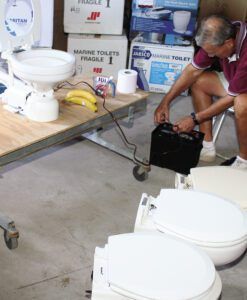
pumps on electric flush toilets impressed
PS testers (see Electic-Flush Marine Toilets, Part 2, PS April 2011).
Vinegar was included in the acids in that report, but we’ve edited it to give vinegar its own section. Conventional wisdom is that white vinegar helps with scale. However, PS testing shows it works so slowly as to be ineffective, and that it is rough on rubber parts and metals in the process. Other acids remove lime faster with less collateral damage, so we’re crossing white vinegar off the list, classifying it instead as a potentially damaging myth.
DODGING STORMS?
Regarding our recent post, “Choosing the Perfect Hurricane Hole,” what about the yachtsman who have no suitable bolt-hole for a hurricane? Could you add some advice about sailing around the edges? With modern weather information giving hour-by-hour advice about the storm’s progress towards the boat, would it be possible to wait for the wind to strengthen and start to back, then use the strengthening wind to sail out to sea, and head south under only a storm headsail/jib? You’d have to plan a route which gives sea-room, particularly if there are surrounding islands or coastlines. Given a well-prepared and seaworthy boat, with a crew who can adapt to such frightening seas, would it be possible to sail around ‘behind’ the storm and so come back to port, eventually, after it has tracked through? Of course, there’s the risk that the storm’s motion of travel could change.
Rob Neal
via PS Online

Going to sea to avoid a tropical cyclone is a common practice among U.S. Navy ships, and commercial vessels. Even for them, the list of caveats is long. With enough warning, the right boat, the right route, plenty of sea room, and the right crew, it is possible to avoid the most dangerous winds. But we’d want to avoid putting ourselves at such a risk. True, the National Hurricane Center’s “Cone of Certainty,” that predicts storm movements has become increasingly accurate. And tropical sailors do must duck tropical storms. Nevertheless, we’d be wary about leaving port with the intent of skirting around a named storm. Often this decision is made too late, and the margin for error or misjudgment is too small. The crew of the tall ship “Bounty,” which was lost in Hurricane Sandy, found this out the hard way (see “The Media on the Bounty,” PS November 2019.) For those unlucky enough to get caught out at sea during cyclone season, the strategy for storm evasion is well established—steer out of the storm’s path and away from dangerous quadrant, batten down, and don’t dither. The practice is described here—with several dated references—in American Practical Navigator (https://en.wikisource.org/wiki/The_American_Practical_Navigator/Chapter_35). Most comprehensive cruising books like the “Art of Seamanship,” by Ralph Naranjo, and “The Voyager’s Handbook,” by Evans Starzinger and Beth Leonard, have a chapter dedicated to storm tactics.
In the link below, sailing writer Steve Dashew runs through the cyclone evasion tactics in his book
“The Mariner’s Weather Handbook,” (https://setsail.com/wp-content/uploads/2013/08/Hurricane_avoidance.pdf). We should point out that Dashew, who sailed in boats that routinely hit double digits, is less than sanguine about the wisdom of trying to dodge a storm when safe refuge is at hand. “The worst possible scenario is to be caught without adequate sea room, and forced to close reach or beat due to local obstructions, while headwinds try and draw you into the storm’s eye,” he writes.
We’ve recently released a four-volume eBook “The Hurricane Preparedness Guide” that offers detailed advice on gear selection and securing your boat for extreme conditions (www.practical-sailor.com/product/hurricane-preparedness-guide-complete-series).
CHECK THAT PUMP IMPELLOR
Re your recent eblast, “Marine Toilet Maintenance Tips” I have two Jabsco electric heads with seawater flush. I had trouble with one not getting enough water so I put a repair kit in it which made no difference. I took it back apart and noticed the impeller housing was worn. I ordered and installed a new housing and it worked like new.
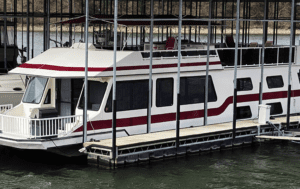
My boat, the Leviathan, is at Lake of the Ozarks in Missouri. It is a 56-foot Forever 10 houseboat built in 1996 by Fun Country Marine. I have owned this boat 19 years. I use the boat in my charter business Lake Adventures. We mostly do trips to Party Cove. She has two cameo appearances on the Netflix series Ozark, Season 1.
Capt. Duane Wood
Leviathan, 56-foot Forever 10
Lake of the Ozarks, MO
As a subscriber, you have free access to our back-issue archive—more than 1,500 articles. Be sure to dive in and dig around when you’re looking for how-to tips or info on sailing products. Here are a few topics you might find relevant this season.
STORM PREP
If you live in a hurricane zone, we’ve got what you need to prepare. Start with our July 2008 report, “Lines, Snubbers, and Other Gear for Battening Down Ahead of Storms” and Technical Editor Ralph Naranjo’s “Tropical Storm Do’s and Don’ts” (November 2011). For serious cruisers, PS recently published an in-depth four volume series on securing your boat at the dock, at anchor, or on a mooring for any type of storm (https://www.practical-sailor.com/product/hurricane-preparedness-guide-complete-series).
NEW BOAT SHOPPING
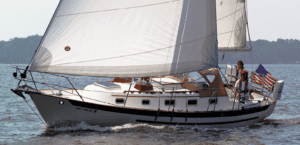
The PS archive includes dozens and dozens of sailboat reviews, from trailer sailers and small cats to racer-cruisers and bluewater voyaging boats built for a family of four. Also the two-volume ebook series “Entry-level Cruiser-Racer” is a compilation of boat reviews of popular racing-cruising boats; available in online bookstore. If you’re planning to carry out a preliminary boat survey—or just want to be well-versed when you go shopping—read “Do-it-yourself survey checklist for boatbuyers,” in the June 2012 issue. Another must-read resource is “A Sailor’s Guide to Marine Insurance,” which was published in the October 2012 issue. New boatowners would also be well-served by Don Casey’s “This Old Boat,” also available at our online bookstore (www.practical-sailor.com/products).
GALLEY OUTFITTING
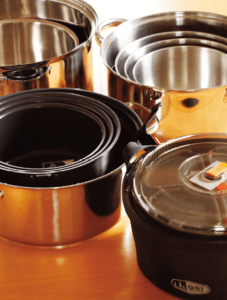
Before you outfit your galley, be sure to read these reviews of galley tools. For those who need quick-fix dinners that can basically cook themselves while you’re on watch (or enjoying cocktail hour), you’ll find our report on pressure cookers in the December 2010 issue and thermal cookers in the May 2016 and September 2012 issues. If you are in the market for a galley oven-range combo, you’ll find our latest test on those in the July 2007 issue, along with an update on small stoves. Two other items we consider cruising-galley staples are the coffeemaker (January 2014) and nesting cookware (April 2009).



































